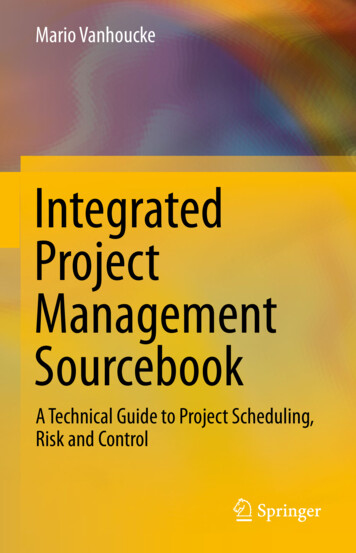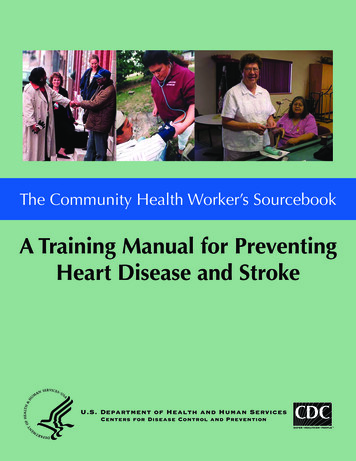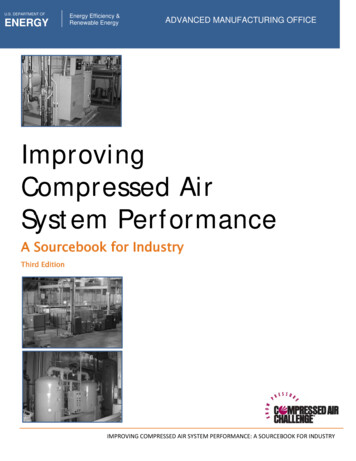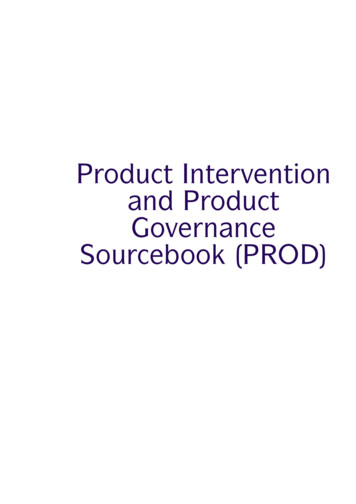
Transcription
Mario VanhouckeIntegratedProjectManagementSourcebookA Technical Guide to Project Scheduling,Risk and Control
Integrated Project Management Sourcebook
Mario VanhouckeIntegratedProject ManagementSourcebookA Technical Guide to Project Scheduling,Risk and Control123
Mario VanhouckeFac. Economics & Business AdministrationGhent UniversityGent, BelgiumISBN 978-3-319-27372-3DOI 10.1007/978-3-319-27373-0ISBN 978-3-319-27373-0 (eBook)Library of Congress Control Number: 2015960270Springer Cham Heidelberg New York Dordrecht London Springer International Publishing Switzerland 2016This work is subject to copyright. All rights are reserved by the Publisher, whether the whole or part ofthe material is concerned, specifically the rights of translation, reprinting, reuse of illustrations, recitation,broadcasting, reproduction on microfilms or in any other physical way, and transmission or informationstorage and retrieval, electronic adaptation, computer software, or by similar or dissimilar methodologynow known or hereafter developed.The use of general descriptive names, registered names, trademarks, service marks, etc. in this publicationdoes not imply, even in the absence of a specific statement, that such names are exempt from the relevantprotective laws and regulations and therefore free for general use.The publisher, the authors and the editors are safe to assume that the advice and information in this bookare believed to be true and accurate at the date of publication. Neither the publisher nor the authors orthe editors give a warranty, express or implied, with respect to the material contained herein or for anyerrors or omissions that may have been made.Printed on acid-free paperSpringer International Publishing AG Switzerland is part of Springer Science Business Media(www.springer.com)
Knowledge is of two kinds. We knowa subject ourselves, or we know wherewe can find information upon it.Samuel Johnson
PrefaceThis book is intended to be an Integrated Project Management Sourcebook forstudents of any project management (PM) course focusing on the integrationbetween baseline scheduling, schedule risk analysis, and project control, known asDynamic Scheduling or Integrated Project Management and Control. It containsa set of C70 articles that are also available online at www.pmknowledgecenter.com. The introduction of the book contains an overview article of the ProjectManagement Knowledge Center with references to a PM bookstore, software tools,research results, and much more material relevant to the reader. The main body ofthis book contains articles on baseline scheduling, risk analysis, and project control.Each individual article focuses on one particular topic, and links are provided to theother articles (chapters) in this book. Almost all articles are accompanied with a setof questions (unlike the articles, these questions cannot be found online), for whichthe answers are provided at the end of this book.This book has been written in the sunlight of Lisbon during my 4-month stay atthe city of light. While artists say that light is all important to creating a masterpiece,I just think back on it as a period where I enjoyed writing in my apartment at Becoda Boavista and on the terraces of Jardim da Praça Dom Luís I (my favorite one,I called it the red terrace), Praça do Comércio, and Portas do Sol but also on theMiradouro de Santa Catarina, the city beach of Cais do Sodré, and of course atUniversidade Aberta de Lisboa. In fact, it is my stay at the city that has become themasterpiece, while the book is simply the result of hard work in complete isolationfrom all Belgian distractions.It goes without saying that the writing of such a manuscript is not an individualwork, but is done in collaboration with people willing to help in many ways.Thank you to friend and colleague José Coelho for the many work meetingswith fruitful and enriching discussions at various places in Lisbon. Thank youto Jordy Batselier, Jeroen Burgelman, Danica D’hont, Louis-Philippe Kerkhove,Pieter Leyman, Annelies Martens, and Vincent Van Peteghem for helping me withproviding a set of questions and for checking the calculations throughout the manyexamples given in each chapter. Thank you to Mathieu Wauters for proofreadingmost of the articles. Thank you Louis-Philippe Kerkhove once again for setting upvii
viiiPrefacea shared online correction system for our research group and for double-checkingthe questions of all the articles over and over again. Thank you to Tom Van Ackerfor providing the IT technology to put all the articles online. Thank you to GaëtaneBeernaert for supporting me in extending this work from an online learning tool toa complete integrated manuscript.Lisbon, PortugalAugust 2015Mario Vanhoucke
Contents1Introduction . . . . . . . . . . . . . . . . . . . . . . . . . . . . . . . . . . . . . . . . . . . . . . . . . . . . . . . . . . . . . . .Welcome to PM Knowledge Center. . . . . . . . . . . . . . . . . . . . . . . . . . . . . . . . . . . . . . .Part I11Baseline Scheduling2Preface . . . . . . . . . . . . . . . . . . . . . . . . . . . . . . . . . . . . . . . . . . . . . . . . . . . . . . . . . . . . . . . . . . . . .BS1: An Introduction to Baseline Scheduling . . . . . . . . . . . . . . . . . . . . . . . . . . . .993Network Analysis . . . . . . . . . . . . . . . . . . . . . . . . . . . . . . . . . . . . . . . . . . . . . . . . . . . . . . . . . .BS2: Activity Networks . . . . . . . . . . . . . . . . . . . . . . . . . . . . . . . . . . . . . . . . . . . . . . . . . . . .BS3: Precedence Relations . . . . . . . . . . . . . . . . . . . . . . . . . . . . . . . . . . . . . . . . . . . . . . . . .BS4: Minimal and Maximal Time-Lags . . . . . . . . . . . . . . . . . . . . . . . . . . . . . . . . . . .BS5: Activity Constraints . . . . . . . . . . . . . . . . . . . . . . . . . . . . . . . . . . . . . . . . . . . . . . . . . .11111620244Resource Analysis . . . . . . . . . . . . . . . . . . . . . . . . . . . . . . . . . . . . . . . . . . . . . . . . . . . . . . . . .BS6: Resource Types . . . . . . . . . . . . . . . . . . . . . . . . . . . . . . . . . . . . . . . . . . . . . . . . . . . . . . .BS7: Critical Path/Chain . . . . . . . . . . . . . . . . . . . . . . . . . . . . . . . . . . . . . . . . . . . . . . . . . . .BS8: Linking Resources . . . . . . . . . . . . . . . . . . . . . . . . . . . . . . . . . . . . . . . . . . . . . . . . . . .BS9: Activity Costs . . . . . . . . . . . . . . . . . . . . . . . . . . . . . . . . . . . . . . . . . . . . . . . . . . . . . . . . .29293136395Scheduling Techniques . . . . . . . . . . . . . . . . . . . . . . . . . . . . . . . . . . . . . . . . . . . . . . . . . . . .Critical Path Scheduling . . . . . . . . . . . . . . . . . . . . . . . . . . . . . . . . . . . . . . . . . . . . . . . . . . .BS10: Activity Slack. . . . . . . . . . . . . . . . . . . . . . . . . . . . . . . . . . . . . . . . . . . . . . . . . . . . .BS11: CPM. . . . . . . . . . . . . . . . . . . . . . . . . . . . . . . . . . . . . . . . . . . . . . . . . . . . . . . . . . . . . . .BS12: Slack Definitions . . . . . . . . . . . . . . . . . . . . . . . . . . . . . . . . . . . . . . . . . . . . . . . . .BS13: Anomalies . . . . . . . . . . . . . . . . . . . . . . . . . . . . . . . . . . . . . . . . . . . . . . . . . . . . . . . .BS14: The Project Scheduling Game . . . . . . . . . . . . . . . . . . . . . . . . . . . . . . . . . . .BS15: PERT . . . . . . . . . . . . . . . . . . . . . . . . . . . . . . . . . . . . . . . . . . . . . . . . . . . . . . . . . . . . . .BS16: A Critical Note on PERT. . . . . . . . . . . . . . . . . . . . . . . . . . . . . . . . . . . . . . . . .Resource Scheduling. . . . . . . . . . . . . . . . . . . . . . . . . . . . . . . . . . . . . . . . . . . . . . . . . . . . . . .BS17: Priority Rule Based Scheduling . . . . . . . . . . . . . . . . . . . . . . . . . . . . . . . . .BS18: Priority Rules . . . . . . . . . . . . . . . . . . . . . . . . . . . . . . . . . . . . . . . . . . . . . . . . . . . . .BS19: Generation Schemes. . . . . . . . . . . . . . . . . . . . . . . . . . . . . . . . . . . . . . . . . . . . .43434346495456596366666973ix
xContentsBS20: Lower Bounds . . . . . . . . . . . . . . . . . . . . . . . . . . . . . . . . . . . . . . . . . . . . . . . . . . . . 78BS21: Validating the Schedule Quality . . . . . . . . . . . . . . . . . . . . . . . . . . . . . . . . . 83Scheduling Objectives . . . . . . . . . . . . . . . . . . . . . . . . . . . . . . . . . . . . . . . . . . . . . . . . . . . . . . 88BS22: What Is My Scheduling Objective? . . . . . . . . . . . . . . . . . . . . . . . . . . . . . 88BS23: Regular and Nonregular Objectives . . . . . . . . . . . . . . . . . . . . . . . . . . . . . 90BS24: Project Lead Time . . . . . . . . . . . . . . . . . . . . . . . . . . . . . . . . . . . . . . . . . . . . . . . 93BS25: Net Present Value. . . . . . . . . . . . . . . . . . . . . . . . . . . . . . . . . . . . . . . . . . . . . . . . 96BS26: Resource Idle Time . . . . . . . . . . . . . . . . . . . . . . . . . . . . . . . . . . . . . . . . . . . . . . 100BS27: Resource Leveling . . . . . . . . . . . . . . . . . . . . . . . . . . . . . . . . . . . . . . . . . . . . . . . 103Part IISchedule Risk Analysis6Preface . . . . . . . . . . . . . . . . . . . . . . . . . . . . . . . . . . . . . . . . . . . . . . . . . . . . . . . . . . . . . . . . . . . . . 109RA1: An Introduction to Risk Analysis . . . . . . . . . . . . . . . . . . . . . . . . . . . . . . . . . . . 1097Schedule Risk Analysis. . . . . . . . . . . . . . . . . . . . . . . . . . . . . . . . . . . . . . . . . . . . . . . . . . . .RA2: Simulating Project Progress . . . . . . . . . . . . . . . . . . . . . . . . . . . . . . . . . . . . . . . . .RA3: CPM Schedule Control . . . . . . . . . . . . . . . . . . . . . . . . . . . . . . . . . . . . . . . . . . . . . .RA4: Activity Distributions . . . . . . . . . . . . . . . . . . . . . . . . . . . . . . . . . . . . . . . . . . . . . . . .RA5: Schedule Sensitivity . . . . . . . . . . . . . . . . . . . . . . . . . . . . . . . . . . . . . . . . . . . . . . . . .RA6: Time Sensitivity . . . . . . . . . . . . . . . . . . . . . . . . . . . . . . . . . . . . . . . . . . . . . . . . . . . . . .Time Sensitivity Measures . . . . . . . . . . . . . . . . . . . . . . . . . . . . . . . . . . . . . . . . . . . . . . . . .RA7: Criticality Index . . . . . . . . . . . . . . . . . . . . . . . . . . . . . . . . . . . . . . . . . . . . . . . . . . .RA8: Pearson’s Cruciality Index . . . . . . . . . . . . . . . . . . . . . . . . . . . . . . . . . . . . . . . .RA9: Kendall’s Tau Cruciality Index . . . . . . . . . . . . . . . . . . . . . . . . . . . . . . . . . . .RA10: Spearman’s Cruciality Index . . . . . . . . . . . . . . . . . . . . . . . . . . . . . . . . . . . .RA11: Schedule Sensitivity Index . . . . . . . . . . . . . . . . . . . . . . . . . . . . . . . . . . . . . .RA12: Significance Index . . . . . . . . . . . . . . . . . . . . . . . . . . . . . . . . . . . . . . . . . . . . . . .1111111151191231261301301341381421461508Buffer Management . . . . . . . . . . . . . . . . . . . . . . . . . . . . . . . . . . . . . . . . . . . . . . . . . . . . . . .RA13: Schedule Protection . . . . . . . . . . . . . . . . . . . . . . . . . . . . . . . . . . . . . . . . . . . . . . . .RA14: Aggressive Estimates . . . . . . . . . . . . . . . . . . . . . . . . . . . . . . . . . . . . . . . . . . . . . . .RA15: Latest Start Schedules . . . . . . . . . . . . . . . . . . . . . . . . . . . . . . . . . . . . . . . . . . . . . .RA16: Buffering . . . . . . . . . . . . . . . . . . . . . . . . . . . . . . . . . . . . . . . . . . . . . . . . . . . . . . . . . . . .Sizing CC/BM Buffers . . . . . . . . . . . . . . . . . . . . . . . . . . . . . . . . . . . . . . . . . . . . . . . . . . . . .RA17: Sizing Buffers . . . . . . . . . . . . . . . . . . . . . . . . . . . . . . . . . . . . . . . . . . . . . . . . . . . .RA18: Cut and Paste Method . . . . . . . . . . . . . . . . . . . . . . . . . . . . . . . . . . . . . . . . . . .RA19: Root Squared Error Method . . . . . . . . . . . . . . . . . . . . . . . . . . . . . . . . . . . . .RA20: Adaptive Density Method . . . . . . . . . . . . . . . . . . . . . . . . . . . . . . . . . . . . . . .RA21: Adaptive Resource Tightness Method . . . . . . . . . . . . . . . . . . . . . . . . . .RA22: Buffer Insertion . . . . . . . . . . . . . . . . . . . . . . . . . . . . . . . . . . . . . . . . . . . . . . . . . . . . .RA23: Resource Conflicts . . . . . . . . . . . . . . . . . . . . . . . . . . . . . . . . . . . . . . . . . . . . . . . . .155155158161166169169172174177182186189Part III9Project ControlPreface . . . . . . . . . . . . . . . . . . . . . . . . . . . . . . . . . . . . . . . . . . . . . . . . . . . . . . . . . . . . . . . . . . . . . 197PC1: An Introduction to Project Control . . . . . . . . . . . . . . . . . . . . . . . . . . . . . . . . . . 197
Contentsxi10 Earned Value Management . . . . . . . . . . . . . . . . . . . . . . . . . . . . . . . . . . . . . . . . . . . . . .PC2: EVM Overview . . . . . . . . . . . . . . . . . . . . . . . . . . . . . . . . . . . . . . . . . . . . . . . . . . . . . . .PC3: EVM Formulary . . . . . . . . . . . . . . . . . . . . . . . . . . . . . . . . . . . . . . . . . . . . . . . . . . . . . .EVM Key Metrics . . . . . . . . . . . . . . . . . . . . . . . . . . . . . . . . . . . . . . . . . . . . . . . . . . . . . . . . . .PC4: Planned Value . . . . . . . . . . . . . . . . . . . . . . . . . . . . . . . . . . . . . . . . . . . . . . . . . . . . .PC5: Key Metrics . . . . . . . . . . . . . . . . . . . . . . . . . . . . . . . . . . . . . . . . . . . . . . . . . . . . . . . .PC6: Earned Value and Schedule . . . . . . . . . . . . . . . . . . . . . . . . . . . . . . . . . . . . . . .EVM Performance Measurement . . . . . . . . . . . . . . . . . . . . . . . . . . . . . . . . . . . . . . . . . .PC7: Performance Scenarios . . . . . . . . . . . . . . . . . . . . . . . . . . . . . . . . . . . . . . . . . . . .PC8: Project Performance . . . . . . . . . . . . . . . . . . . . . . . . . . . . . . . . . . . . . . . . . . . . . . .PC9: Time Performance . . . . . . . . . . . . . . . . . . . . . . . . . . . . . . . . . . . . . . . . . . . . . . . . .EVM Forecasting . . . . . . . . . . . . . . . . . . . . . . . . . . . . . . . . . . . . . . . . . . . . . . . . . . . . . . . . . . .PC10: Forecasting. . . . . . . . . . . . . . . . . . . . . . . . . . . . . . . . . . . . . . . . . . . . . . . . . . . . . . .PC11: Forecasting Time . . . . . . . . . . . . . . . . . . . . . . . . . . . . . . . . . . . . . . . . . . . . . . . . .PC12: Forecasting Cost . . . . . . . . . . . . . . . . . . . . . . . . . . . . . . . . . . . . . . . . . . . . . . . . . .PC13: Forecast Accuracy . . . . . . . . . . . . . . . . . . . . . . . . . . . . . . . . . . . . . . . . . . . . . . .Schedule Adherence . . . . . . . . . . . . . . . . . . . . . . . . . . . . . . . . . . . . . . . . . . . . . . . . . . . . . . . .PC14: Schedule Adherence. . . . . . . . . . . . . . . . . . . . . . . . . . . . . . . . . . . . . . . . . . . . .PC15: Effective Earned Value . . . . . . . . . . . . . . . . . . . . . . . . . . . . . . . . . . . . . . . . . .PC16: Schedule Inadherence . . . . . . . . . . . . . . . . . . . . . . . . . . . . . . . . . . . . . . . . . . . 4124124424711 Schedule Control . . . . . . . . . . . . . . . . . . . . . . . . . . . . . . . . . . . . . . . . . . . . . . . . . . . . . . . . . .PC17: Bottom-Up Control. . . . . . . . . . . . . . . . . . . . . . . . . . . . . . . . . . . . . . . . . . . . . . . . .PC18: Top-Down Control . . . . . . . . . . . . . . . . . . . . . . . . . . . . . . . . . . . . . . . . . . . . . . . . . .PC19: Why It Works/Fails . . . . . . . . . . . . . . . . . . . . . . . . . . . . . . . . . . . . . . . . . . . . . . . . . .PC20: Retained and Overridden Logic . . . . . . . . . . . . . . . . . . . . . . . . . . . . . . . . . . . .PC21: Updating Schedules . . . . . . . . . . . . . . . . . . . . . . . . . . . . . . . . . . . . . . . . . . . . . . . . .251251255258262267Part IVSolutions12 Solutions . . . . . . . . . . . . . . . . . . . . . . . . . . . . . . . . . . . . . . . . . . . . . . . . . . . . . . . . . . . . . . . . . . . .Baseline Scheduling . . . . . . . . . . . . . . . . . . . . . . . . . . . . . . . . . . . . . . . . . . . . . . . . . . . . . . . .Schedule Risk Analysis . . . . . . . . . . . . . . . . . . . . . . . . . . . . . . . . . . . . . . . . . . . . . . . . . . . .Project Control . . . . . . . . . . . . . . . . . . . . . . . . . . . . . . . . . . . . . . . . . . . . . . . . . . . . . . . . . . . . .275275279283
Chapter 1IntroductionWelcome to PM Knowledge Center1Project baseline scheduling, risk analysis and project control are crucial steps in thelife of a project. The project manager uses the project schedule to help planning,executing and controlling project activities and to track and monitor the progressof the project. A major component of a project schedule is a work breakdownstructure (WBS). However, the basic critical path method (CPM) schedules, or itsoften more sophisticated extensions, are nothing more than the starting point forschedule management. Information about the sensitivity of the various parts of theschedule, quantified in schedule risk numbers or of a more qualitative nature, offersan extra opportunity to increase the accuracy of the schedules and might serveas an additional tool to improve project monitoring and tracking. Consequently,project scheduling and monitoring/control tools and techniques should give projectmanagers access to real-time data including activity sensitivity, project completionpercentages, actuals and forecasts on time and cost in order to gain a betterunderstanding of the overall project performance and to be able to make fasterand more effective corrective decisions. All this requires understandable projectperformance dashboards that visualize important key project metrics that quicklyreveal information on time and cost deviations at the project level or the activitylevel. During monitoring and tracking, the project manager should use all thisinformation and should set thresholds on the project level or on lower WBS levels toreceive warning signals during project execution. These thresholds serve as triggersto take, when exceeded, corrective actions.This triangular role of a project schedule is often labeled as dynamic scheduling(see Fig. 1.1) to highlight the need and ability of project scheduling software1This section is also available as an article entitled “Dynamic scheduling: Welcome to PMKnowledge Center” published online at PM Knowledge Center. Springer International Publishing Switzerland 2016M. Vanhoucke, Integrated Project Management Sourcebook,DOI 10.1007/978-3-319-27373-0 11
21 IntroductionFig. 1.1 Dynamic scheduling: the baseline schedule, risk management and project control triangleto dynamically create a baseline schedule environment that provides informationduring project execution and that can be easily adapted using the new informationduring project monitoring and tracking. Consequently, the three dimensions ofdynamic scheduling can be summarized as follows: Baseline schedule construction: A project baseline schedule visualized in a Ganttchart acts as a point of reference in the project life cycle. It should especiallybe considered as nothing more than a predictive model that can be used forresource efficiency calculations, time and cost risk analysis, project trackingand performance measurement, and so on (see section “BS1: An Introductionto Baseline Scheduling” on page 9). Schedule risk analysis: When management has a certain feeling of the relativesensitivity of the various project activities on the project objective, a bettermanagement’s focus and a more accurate response during project tracking shouldpositively contribute to the overall performance of the project. Through the use ofbuffers inserted into the baseline schedule, the project is better protected againstunexpected delays and corrective actions can be restricted to a minimum (seesection “RA1: An Introduction to Risk Analysis” on page 109). Project control: Using dynamic information during project progress to improvecorrective action decisions is the key target of project monitoring and control.The performance information obtained through EVM will be dynamically usedto steer the corrective action decision making process and improve the overallsuccess of the project (see section “PC1: An Introduction to Project Control” onpage 197).This book acts as an Integrated Project Management Sourcebook on dynamicscheduling, integrating these three dimensions in three different parts of the book.It is considered to be part of the Project Management Knowledge Center (furtherabbreviated as PM Knowledge Center or PMKC) that is the topic of this chapter.
Welcome to PM Knowledge Center3The purpose of PM Knowledge Center is to act as a Project Management guide forstudents, lecturers and professionals interested in the field of Dynamic Scheduling.All topics described in the articles are based on research done at Ghent University(Belgium). Additionally, the aim of PMKC is to share knowledge and invoke interestin Project Management. To that purpose, a number of tools are available, that aresummarized along the following lines. ORASTalks app: Stimulate interactionProTrack: Dynamic scheduling on your desktopBusiness Game: Learning by doingBookstore: Literature for students and professionalsP2 Engine: Advancing the state-of-the-art knowledgeResearch: Project Management researchORASTalksThe main purpose of PM Knowledge Center is to interact with our audienceconsisting of undergraduate and graduate students, MBAs and practitioners. Allsummary articles of PM Knowledge Center in this book are therefore also freelyavailable from the website www.pmknowledgecenter.com. In order to get andstay in contact with our PMKC audience, a free mobile app has been developed.ORASTalks is an app that aims at bringing students together to offer them acentral place for their course content, to provide them with additional backgroundinformation and to bring them in contact with interested professionals. OR-AS isan acronym for “Operations Research—Applications and Solutions” and developssoftware Applications and Solutions for academia and business based on a wellbalanced combination between academic knowledge and practical experience.It serves as a bridge between the academic environment of our university andMBA students and the business world that they will soon (re-)discover after theirgraduation. The specific approach to improve and optimise business processesconsists of data analysis, simulation and optimisation using state-of-the-art tools andtechniques, followed by the implementation and validation. The field of OperationsResearch is applicable to many complex business processes. Special attention willbe devoted to Integrated Project Management and Control using well-known as wellas novel project management tools and techniques. More information can be foundat www.or-as.be/orastalks.ProTrackProTrack 3.0 is a complete redesigned version of the smart version of ProTrack 2.0.Its integration with PM Knowledge Center and its strong focus on the integration of
41 Introductionbaseline scheduling, risk analysis and project control makes it yet a stronger learningtool to stimulate interaction between researchers, students and practitioners in thefield of project management and dynamic scheduling. Go to www.protrack.be, buy,interact and. . . enjoy! More information can be found at www.protrack.be.Business GameThe Project Scheduling Game (PSG) is an IT-supported simulation game to getacquainted with dynamic project scheduling using the critical path method (CPM).The critical path method involves a time/cost trade-off in project activities andrequire the construction of a project baseline schedule within a predefined projectdeadline and budget. The uncertainty during project progress disturbs the originalbaseline schedule and requires interventions to bring the project back on track. Moreinformation can be found at www.protrack.be/psg.BookstoreThe themes discussed in PM Knowledge Center are the result of research projects atGhent University and Vlerick Business School and the development of a commercialsoftware tool ProTrack at OR-AS. Currently, three books published by Springer areavailable (see Fig. 1.2 or www.or-as.be/books): Integrated Project Management and Control: First comes the theory, then thepractice: A summary book on Earned Value Management and Schedule RiskFig. 1.2 PMKC bookstore: three books published by Springer
Welcome to PM Knowledge Center5Fig. 1.3 PMKC bookstore: the three editions of “The Art of Project Management”Analysis, containing example projects and reports, as well as an overview of theP2 Engine tool. Project Management with Dynamic Scheduling: Baseline scheduling, risk analysis and project control: An overview book on the three main themes of dynamicscheduling, containing overview chapters, cases studies and a tutorial for theProTrack software tool. Measuring Time: Improving project performance using Earned Value Management: A project control research study awarded by the Belgian chapter ofthe Project Management Institute (PMI-Belgium) and the International ProjectManagement Association (IPMA).A fourth book is published as a free online pdf at www.or-as.be/books/workand passion. The first edition is published in 2014 and ever since a yearly updatehas been put online, resulting in the third edition in 2015, as shown in Fig. 1.3: The Art of Project Management: A Story about Work and Passion: This bookgives you an overview of the OR-AS endeavors done in the past and the ideasthat will be done in the future. It tells about the products and ideas of OR-AS andgives you a brief overview of the most important people who inspired us and theOR-AS products. It tells about work, and the passion that has led to the results ofthe hard work. It’s not a scientific book. It isn’t a managerial book either. It’s justa story . . . about work and passionP2 EngineP2 Engine is a command line utility tool based on the LUA scripting language togenerate gigabytes of project data. It generates project baseline scheduling data andrisk analysis metrics as well as dynamic project progress data that can be used for
61 Introductiontesting and validating novel research ideas. P2 Engine gives the user access to thecomplexity of various project analysis algorithms incorporated in ProTrack 3.0. Theresearcher can solve difficult and critical dynamic project scheduling optimizationproblems using ProTrack’s intelligent algorithms. It can easily produce a enormousdatabase of optimization results for a wide range of project management problemsfaster than ever before and advance the state-of-the-art knowledge available today.More information on P2 Engine can be found www.p2engine.com.ResearchAll articles, books and the software tool ProTrack are the result of years of academicresearch. Most research done before and during the continuous development ofProTrack can be situated in the so-called Project Life Cycle (PLC, see Fig. 1.4).This cycle defines all phases between the start and end of the life of a project, andhas been extensively described in various sources.The aim of the research is threefold. First, the research goal is to search fordeterminants that influence the accuracy of earned value based predictive methods toforecast a project’s final duration. A distinction is made between static determinants,which can be calculated before the start of the project (i.e. during the definitionand scheduling phases, see study 1 of the Fig. 1.4) and dynamic determinants,which can be calculated during the project’s execution and control phases (seestudy 2). Obviously, the ultimate goal is not the accuracy for the sake of accuracy,but rather to use this static and dynamic information to guide and improve thecorrective action decision making process (see study 3). More information on thelatest obtained research funding can be found at www.or-as.be or at the researchsite of the Operations Research and Scheduling group at www.projectmanagement.ugent.be.Fig. 1.4 The project life cycle and the three integrative studies used in all research studies
Part IBaseline Scheduling
Chapter 2PrefaceBS1: An Introduction to Baseline Scheduling1Baseline scheduling can be defined as the act of constructing a timetable to providea start and end date for each project activity, taking activity relations, resourceconstraints and other project characteristics into account and aiming at reachinga certain scheduling objective.The construction of a project baseline schedule is often a time-consuming andcumbersome task. However, the central role of the baseline schedule in a schedulerisk analysis (see section “RA1: An Introduction to Risk Analysis” on page 109)and in the project control phase (see section “PC1: An Introduction to ProjectControl” on page 197) cannot be underestimated. It should indeed be generallyaccepted that the usability of a project baseline schedule is to act as a point ofreference in the project life cycle, and hence, a project schedule should especiallybe considered as nothing more than a predictive model that can be used forresource efficiency calculations, time and cost risk analyses, project tracking andperformance measurement, and so on.The baseline scheduling topics of this book have been classified in the followingcategories: Network analysis Resource analysis Scheduling techniquesFor an overview of the three dynamic scheduling dimensions, see
Project baseline scheduling, risk analysis and project control are crucial steps in the life of a project. The project manager uses the project schedule to help planning, executing and controlling project activities and to track and monitor the progress of the project. A major component of a project schedule is a work breakdown structure (WBS).










